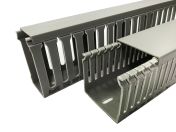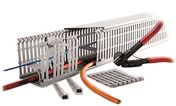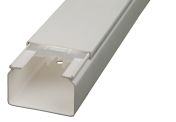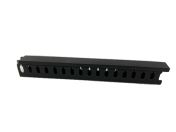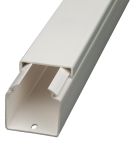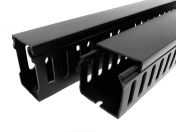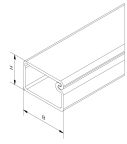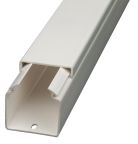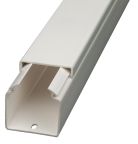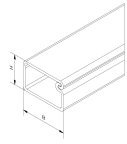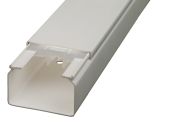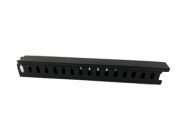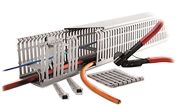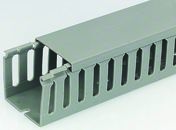- Automation & Control Gear
- Cables & Wires
- Enclosures & Server Racks
- Fuses & Circuit Breakers
- HVAC, Fans & Thermal Management
- Lighting
- Relays & Signal Conditioning
- Switches
- Batteries & Chargers
- Connectors
- Displays & Optoelectronics
- ESD Control, Cleanroom & PCB Prototyping
- Passive Components
- Power Supplies & Transformers
- Raspberry Pi, Arduino, ROCK, STEM Education & Development Tools
- Semiconductors
Cable Trunking
Otherwise known as known as cable duct, cable channel, or wireway, cable trunking is a system used to organise and protect electrical cables or wires in buildings or industrial settings. It provides a safe and tidy way to route and conceal cables, improving the overall appearance and safety of the installation.
Cable trunking typically consists of a rectangular or square-shaped enclosure made of plastic, metal, or sometimes rubber. The enclosure has a removable or hinged cover, allowing easy access to the cables when necessary. The trunking is designed with various compartments or channels to accommodate multiple cables of different types and sizes.
What Is Cable Trunking Used For?
- Cable Protection: Trunking shields cables from physical damage, such as impact, crushing, or accidental contact with sharp objects, which could potentially cause short circuits, electrical shocks, or fires.
- Cable Organisation: Trunking helps to keep cables organised and prevents them from becoming tangled or snarled, making it easier to identify and manage individual cables during installation, maintenance, or repairs. This is especially useful in cable-heavy settings like data transfer in heavy servers with ethernet cables where stray cables pose tripping hazards for workers.
- Safety and Aesthetics: By concealing cables or ducts within trunking, the system reduces trip hazards and improves the overall appearance of the space. It also prevents dust accumulation on the cables, which can be a fire hazard.
- Electromagnetic Interference (EMI) Protection: Some types of trunking are designed with features like metal shielding or grounding capabilities, which help to reduce electromagnetic interference or electromagnetic radiation emitted by the cables.
- Versatility: Cable trunking is available in various sizes and materials (like PVC or metal) to accommodate different types of cables and installation environments. It can be used in residential, commercial, and industrial applications.
- Compliance: Trunking systems often meet safety standards and regulations, ensuring that installations adhere to legal requirements for electrical safety.
Types of Cable Trunking
- PVC Cable Trunking: Polyvinyl chloride (PVC) trunking is the most common type and widely used in various applications. It is affordable, lightweight, and easy to install. PVC trunking is available in different sizes, shapes, and colours, allowing for flexibility in cable management.
- Metal Cable Trunking: Metal trunking, usually made of steel or aluminium, offers robustness and durability. It provides excellent protection against physical damage, such as impact or crushing. Metal trunking is often used in industrial environments or areas where there may be a higher risk of mechanical stress or where fire resistance is required.
- Adhesive Cable Trunking: Adhesive trunking, also known as self-adhesive trunking, comes with a pre-applied adhesive strip on the back. It simplifies installation by allowing the trunking to be directly stuck to walls, ceilings, or other surfaces without the need for additional fixings. Adhesive trunking is commonly used in situations where drilling holes for mounting is not desirable.
- Flexible Cable Trunking: Flexible trunking, typically made of plastic or rubber, is designed to accommodate cables that require bending or routing around corners. It is especially useful when dealing with cables in confined or complex spaces. Flexible wire trunking often comes in the form of coiled or spiral wraps that can expand, and contract as needed.
How to Choose the Right Cable Trunking For Your Project
Selecting the correct size and type of cable trunking is crucial for effective wire management and electrical safety. Follow this guide to ensure you choose the perfect trunking wiring solution for your project:
- Calculate Your Cable Capacity: Determine the amount of space you will need to accommodate all your cables. Add 20-40% extra room to allow space for future expansion.
- Consider the Material: Consider whether PVC or metal trunking suits your needs best. PVC cable trunking is popular for its affordability and ease of installation, while metal trunking offers superior durability.
- Keep Ventilation and Maintenance in Mind: Apply the 40% fill rule to ensure proper ventilation and make maintenance easier. This helps prevent overheating and allows room for future adjustments.
- Factor in Bends and Connectors: Take into account the bend radius of your cables and the space needed for connectors and joints. This ensures smooth cable ducting and wire ducting runs.
Maintaining and Upgrading Electrical Trunking
Regular maintenance is crucial for the longevity of your cable trunking system. Conduct routine inspections of your trunking wiring to check for damage such as cracks, warps, or loose fittings. Keep your PVC cable trunking or metal trunking clean by removing dust and debris to prevent overheating. Lastly, do not forget to regularly examine the cables within, ensuring they remain undamaged and properly seated to avoid electrical issues and safety hazards.
As your needs evolve, consider upgrading your cable ducting system. You might expand capacity by replacing smaller trunking with larger options or adding parallel runs. If you initially installed PVC cable trunking, upgrading to metal trunking could be beneficial for increased durability in high-stress environments. For layouts that change frequently, consider flexible wire trunking as it offers an adaptable solution that allows for easy modifications without needing a complete system overhaul.
You can also consider future-proofing your electrical ducting by opting for modular designs that accommodate easy additions or modifications. Leave extra space in your trunking for potential future additions, such as fibre optic or new data cables. You should also maintain detailed records of your current installation to facilitate smooth upgrades or modifications in the future.
By following these practices, you can ensure your cable trunking system will remain efficient, compliant, and adaptable to your changing needs for years to come.
Industry Applications of Cable Trunking
Cable trunking and ducting systems are crucial components across various sectors in Malaysia, streamlining cable management and enhancing safety and efficiency. By segregating and protecting wires and cables, trunking systems help to address industry-specific needs, from enhancing operational efficiency to complying with strict regulatory standards.
Commercial and Office Buildings
Cable trunking is extensively used to manage and protect communications and power cables, from ethernet cables to fibre optic cables and beyond. It not only facilitates easier access and identification of different communications cables but also significantly reduces the risk of tripping hazards, contributing to a safer workplace. Moreover, in areas where aesthetic integration is important, sleek and discreet PVC cable trunking systems can blend seamlessly with modern décor, maintaining the visual integrity of office spaces in Malaysia.
Manufacturing and Industrial Facilities
Trunking systems in manufacturing and industrial facilities must be robust to withstand the rigours of harsh operational conditions. In sectors where heavy machinery and high-power equipment are involved, metal trunking offers a durable solution that protects wiring from heat, dust, and mechanical damage. Implementing proper cable trunking aids in system organisation and reduces electrical interference, crucial for the accurate functioning of machinery. It also plays a critical role in emergency situations, ensuring that power can be quickly and safely cut off when necessary to avoid accidents.
Healthcare Facilities
Proper PVC and metal cable trunking systems ensure that medical devices that require uninterruptible power supplies are continuously powered, without any risk of disconnection or electrical interference. In surgical areas, trunking with antimicrobial properties can be used to enhance infection control measures. Additionally, the ability to quickly access and manage these systems during upgrades or maintenance minimises disruption to healthcare services, a crucial factor in environments where even the slightest downtime can affect patient care outcomes.
Food and Beverage Facilities
The primary concern for trunking systems in the food and beverage industry is maintaining hygiene alongside protecting wiring from exposure to moisture, heat, and cleaning chemicals. PVC trunking is particularly advantageous in these settings due to its non-corrosive properties and ease of cleaning. It can even be easily sanitised to prevent the accumulation of bacteria and debris, which is paramount in maintaining food safety standards and keeping consumers and employees safe. Furthermore, the use of slotted wire ducting allows for better airflow around cables, which helps in preventing overheating and prolonging the life of electrical components.
Your Trusted Electrical Cable Trunking Supplier and Manufacturer
When it comes to organising and protecting your electrical cables, RS Malaysia is your reliable partner. We offer a comprehensive range of high-quality cable trunking solutions from leading brands like HellermannTyton, Schneider Electric, Igus, and our in-house brand, RS PRO. Our selection includes various sizes, materials, and styles to meet the diverse needs of residential, commercial, and industrial applications.
At RS, we are committed to providing our customers with not only top-quality products but also exceptional service. Our team of technical experts is available to offer guidance and support, helping you choose the right cable trunking system for your specific requirements. We also offer next-day delivery options to ensure a seamless and efficient experience for our customers. For more delivery information, please refer to our delivery policy.
Popular Searches
Related links
- RS PRO White Cable Trunking L2m, PVC
- RS PRO White Cable Trunking L2m, PVC
- RS PRO White Mini Trunking L2m, PVC
- RS PRO Grey Slotted Panel Trunking - Open Slot L2m, PVC
- Cable Trunking Accessories
- RS PRO Grey Slotted Panel Trunking - Open Slot L2m, PVC
- RS PRO Black Slotted Panel Trunking - Open Slot L2m, PVC
- RS PRO PVC Cable Trunking External Cover, 110 x 60mm

